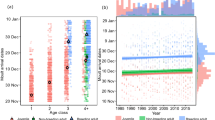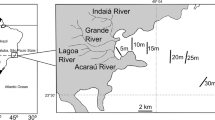Abstract
In a 14-d period 38 swarms of Antarctic krill,Euphausia superba Dana, were sampled in an area 55.5 x 55.5 km to the southwest of Elephant Island, at the north of the South Shetland Islands. Moult stage, maturity stage, and size of ca. 100 krill from each swarm were measured. Each of the characteristics varied greatly between swarms. Moulting krill were found in most swarms, but in one swarm all of the krill were just about to moult. Ways in which moulting may act as a possible sorting mechanism are discussed. Data for all the analysed krill (ca. 3000 specimens) were used to investigate the interdependence of moult rate, sexual maturation and growth. While all immature krill moulted at approximately the saine rate in the study, there were significant differences in the moulting rates of mature male and female krill. Gravid female krill continued to moult, although less frequently than mature males. As a consequence males had to attach spermatophores to females after each moult. It is likely that variation in moult rate of females and males was related to the energy expenditure required for ovary development in females and spermatophore production and searching behaviour in males. Spawning and moulting were only partly coupled in gravid females. Spawning appeared to take place predominantly during Moult Stage D2. There was no evidence of intermoult growth by intersegmental dilation.
Similar content being viewed by others
References
Antezana T, Ray K (1983) Aggregation ofEuphausia superba as an adaptive group strategy to the Antarctic ecosystem. Ber Polarforsch (Bremerhaven) 4: 199–215
Bone DG (1986) An LLHPR system for adult Antarctic krill (Euphausia superba). Br Antarct Surv Bull 73: 31–47
Buchholz C, Buchholz F (1989) Ultrastructure of the integument of a pelagic crustacean: moult cycle related studies on the Antarctic krill,Euphausia superba. Mar Biol 101: 355–365
Buchholz F (1982) Drach's molt staging system adapted for euphausiids. Mar Biol 66: 301–305
Buchholz F (1985) Moult and growth in euphausiids. In: Siegfried WR, Condy PR, Laws RM (eds) Antarctic nutrient cycles and food webs. Springer-Verlag, Berlin, pp 339–345
Buchholz F (1991) Moult cycle and growth of Antarctic krillEuphausia superba in the laboratory. Mar Ecol Prog Ser 69: 217–229
Buchholz F, Morris DJ, Watkins JL (1989) Analyses of field moult data: prediction of intermoult period and assessment of seasonal growth in Antarctic krill,Euphausia superba Dana. Antarctic Sei 1: 301–306
Carr WES (1988) The molecular nature of chemical stimuli in the aquatic environment. In: Atema J, Fay RR, Popper AN, Travolga WN (eds) Sensory biology in the aquatic environment. Springer-Verlag, New York, pp 3–27
Clarke A (1976) Some observations on krill (Euphausia superba Dana) maintained alive in the laboratory. Br Antarct Surv Bull 43: 111–118
Cuzin-Roudy J (1987) Gonad history of the Antarctic krillEuphausia superba Dana during its breeding season. Polar Biol 7: 237–244
Cuzin-Roudy J, Tchernigovtzeff C (1985) Chronology of the female molt-cycle inSiriella armata M.-Edw. (Crustacea: Mysidacea) based on marsupial development. J Crustacean Biol 5: 1–14
Farber-Lorda J (1990) Somatic length relationships and ontogenetic morphometric differentiation ofEuphausia superba andThysanoessa macrura of the southwest Indian Ocean during summer (February 1981). Deep-Sea Res 37: 1135–1143
Hamner WM, Hamner PP, Strand SW, Gilmer RW (1983) Behavior of Antarctic krill,Euphausia superba: chemoreception, feeding, schooling, and molting. Science NY 220: 433–435
Hartnoll RG (1985) Growth, sexual maturity and reproductive output. In: Wenner AM (ed) Factors in adult growth. Balkema, Rotterdam, pp 101–128
Kalinowski J, Witek Z (1985) BIOMASS Handbook No. 27: scheme for classifying aggregations of Antarctic krill. SCAR, Cambridge
Kils U (1981) Size dissociation in krill swarms. Kieler Meeresforsch 5(Sdhft): 262–263
Macaulay MC, English TS, Mathisen OA (1984) Acoustic characterization of swarms of Antarctic krill (Euphausia superba) from Elephant Island and Bransfield Strait. J Crustacean Biol 4 (Spec No 1): 16–44
Mackintosh NA (1967) Maintenance of livingEuphausia superba and frequency of moults. Norsk Hvalfangsttid 5: 97–102
Makarov RR, Denys CJ (1981) BIOMASS Handbook No. 11: stages of sexual maturity of Euphausia superba Dana. SCAR, Cambridge
Marr JWS (1962) The natural history and geography of the Antarctic krill (Euphausia superba Dana). Discovery Rep 32: 33464
Mauchline J (1973) Intermoult growth of species of Mysidacea. J mar biol Ass UK 53: 569–572
Mauchline J (1980) The biology of mysids and euphausiids. Adv mar Biol 18: 1–681
Meixner R (1969) Wachstum, Häutung und Fortpflanzung vonCrangon crangon bei Einzelaufzucht. Meeresforsch Rep mar Res (Ber dt wiss Kommn Meeresforsch) 20: 93–111
Miller DGM, Hampton I (1989) BIOMASS Scientific Series No. 9: biology and ecology of the Antarctic krill (Euphausia superba Dana): a review. SCAR and SCOR, Scott Polar Research Institute, Cambridge
Morris DJ, Watkins JL, Ricketts C, Buchholz F, Priddle J (1988) An assessment of the merits of length and weight measurements of Antarctic krillEuphausia superba. Br Antarct Surv Bull 79: 27–50
Payne RW, Lane PW, Ainsley AE, Bicknell KE, Digby PGN, Gower JC, Harding SA, Leech PK, Simpson HR, Todd AD, Verrier PJ, White RP, Tunnicliffe-Wilson G, Paterson LJ (1987) GENSTAT 5 reference manual. Oxford University Press, Oxford
Pond D, Watkins JL, Priddle J, Sargent J (1995) Variation in the lipid content and composition of Antarctic krill (Euphausia superba) at South Georgia. Mar Ecol Prog Ser 117: 49–57
Priddle J, Watkins JL, Morris DJ, Ricketts C, Buchholz F (1990) Variation of feeding by krill in swarms. J Plankton Res 12: 1189–1205
Ricketts C, Watkins JL, Morris DJ, Buchholz F, Priddle J (1992) An assessment of the biological and Aoustic characteristics of swarms of Antarctic krill. Deep-Sea Res 39: 359–371
Rosenberg AA, Beddington JR, Basson M (1986) Growth and longevity of krill during the first decade of pelagic whaling. Nature, Lond 324: 152–154
Ross RM, Quetin LB (1983) Spawning frequency and fecundity of the Antarctic krillEuphausia superba. Mar Biol 77: 201–205
Sachs L (1984) Angewandte Statistik. Springer-Verlag, Berlin
Siegel V (1987) Age and growth of Antarctic Euphausiacea (Crustacea) under natural conditions. Mar Biol 96: 483–495
Siegel V, Kalinowski J (1994) Krill demography and small-scale processes: a review. In El-Sayed SZ (ed) Southern Ocean ecology: the BIOMASS perspective. Cambridge University Press, Cambridge, pp 145–163
Watkins IL (1986) Variations in the size of Antarctic krill,Euphausia superba Dana, in small swarms. Mar Ecol Prog Ser 31: 67–73
Watkins JL, Buchholz F, Priddle J, Morris DJ, Ricketts C (1992) Variation in reproductive status of Antarctic krill swarms; evidence for a size-related sorting mechanism? Mar Ecol Prog Ser 82: 163–174
Watkins JL, Morris DJ, Ricketts C, Murray AWA (1990) Sampling biological characteristics of krill: effect of heterogeneous nature of swarms. Mar Biol 107: 409–415
Watkins JL, Morris DJ, Ricketts C, Priddle J (1986) Differences between swarms of Antarctic krill and some implications for sampling krill populations. Mar Biol 93: 137–146
Author information
Authors and Affiliations
Additional information
Communicated by O. Kinne, Oldendorf/Luhe
Rights and permissions
About this article
Cite this article
Buchholz, F., Watkins, J.L., Priddle, J. et al. Moult in relation to some aspects of reproduction and growth in swarms of Antarctic krill,Euphausia superba . Mar. Biol. 127, 201–208 (1996). https://doi.org/10.1007/BF00942104
Received:
Accepted:
Issue Date:
DOI: https://doi.org/10.1007/BF00942104




